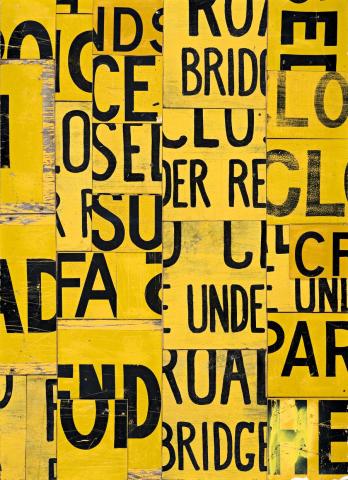NEWS BREAK, 1994
ROSALIE GASCOIGNE
retro-reflective and painted road signs on plywood
131.0 x 95.0 cm
signed, dated and inscribed verso: Rosalie Gascoigne/ 1994 / News Break
Roslyn Oxley9 Gallery, Sydney
Private collection, Melbourne
Romantisystem, Canberra Contemporary Art Space, Canberra, 2-31 July 1994
(This work was specifically made for 'Romantisystem' at the request of the curator, Trevor Smith)
Rosalie Gascoigne, Roslyn Oxley9 Gallery, Sydney, 23 Aug - 16 Sept 1995, cat.15
Macdonald V., Rosalie Gascoigne, Regaro Pty Ltd, Sydney, 1998, p.77, 108 & 114, pl.38 (illus.)
Although universally regarded as one of the most significant Australian artists of the twentieth century, remarkably Rosalie Gascoigne did not hold her first exhibition until the age of 57. Immediately attracting the praise of collectors and critics alike, she was soon offered a major survey exhibition at the National Gallery of Victoria (1978) and in 1982, was selected to represent Australia at the Venice Biennale (alongside Peter Booth), being the first Australian woman to receive this honour. In more recent years, she has featured in numerous important and international exhibitions - including the prestigious solo show Material as Landscape, (1997-98) - and today is represented in all major collections in Australia and New Zealand, as well as the Museum of Modern Art, New York.
Of all Rosalie Gascoigne's achievements, undoubtedly the most striking and widely celebrated are her black-on-gold assemblages which, initially incorporating printed planks cut from wooden Schweppes soft drink crates progress to more minimalist compositions featuring retro-reflective road signs such as News Break. Discussing the present work, interestingly the artist observes, 'Some of it isn't reflective. You can tell by the writing. The stuff which is non-reflective is hand-done lettering. And the rest is machine-done lettering, it's good...'1 Having eschewed the use of iconography, Gascoigne thus transforms text into texture - a wordplay of which she is no doubt aware - to evoke a powerful sense of landscape and light. With their rhythmic pattern composed of letters, such works have not surprisingly been described as 'concrete stammering poems'2 - a perceptive analogy, especially given the artist's predilection for poetry from Shakespeare to Plath. Notwithstanding, Gascoigne stresses that the flickering word fragments, though carefully arranged, are not intended to be read literally: 'Placement of letters is important, but it's not a matter of reading the text - it's a matter of getting a visually pleasing result.'3 Similarly, her titles are not literal but rather, 'leave room for the viewer', imbued with multiple levels of meaning to be deciphered.
Notably, News Break was created specifically for Romantisystem, (1995), Trevor Smith's debut exhibition as Director of the Canberra Contemporary Art Space in which he posited questions about audience viewing habits by not providing a catalogue at the time, announcing instead that such would be available after the exhibition had closed. With the works selected therefore operating as part of an unarticulated text about the nature of (some) contemporary art practice, the exhibition challenged a stylistic cliché that cool or systematic (work) is somehow less personal [and] more expressionist work is somehow a direct trace of the artist's inner feelings.'4 Exploiting the multifaceted ambiguity manifest in the exhibition's title, thus News Break suggests that one does not negate the other but rather, the supposedly expressive ('Romanticism') and the regulated ('system') coexist in happy compatibility.
1. MacDonald, V., Rosalie Gascoigne, Regaro, Sydney, 1998, p.77
2. ibid., p.34
3. ibid., p.35
4. Trevor Smith cited in Art and Australia, vol.32, no.3, 1995, p.443
VERONICA ANGELATOS
